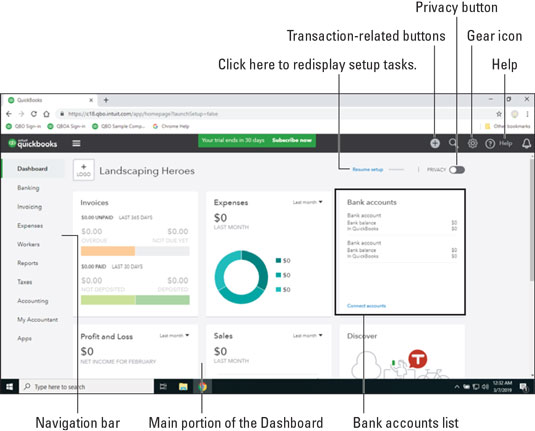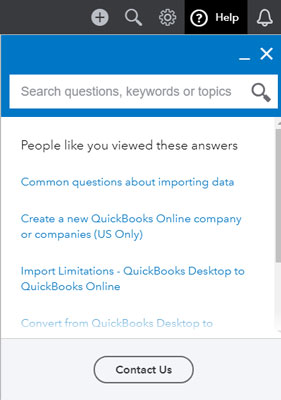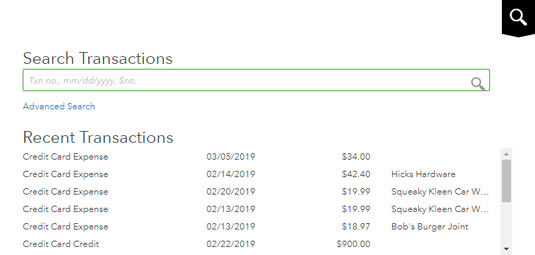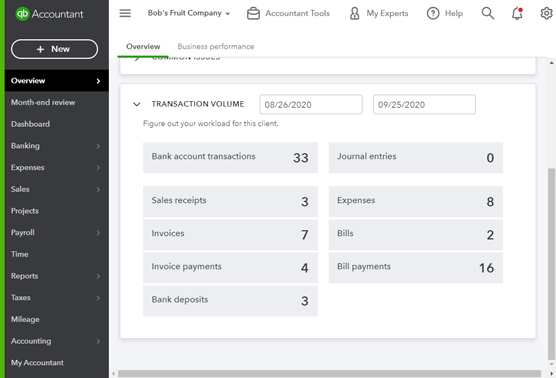To hide the options, click Hide in the upper right corner of the box. Don’t worry, you can still set up the options associated with any of these boxes; in the following figure, notice the Resume Setup link in the upper right corner of the Dashboard. Click it to redisplay the setup options. And, once you close the boxes, your Dashboard page displays information specific to your company.
 The QBO Dashboard page after closing the additional setup box.
The QBO Dashboard page after closing the additional setup box.In the center of the figure, using most of the Dashboard page real estate, you find information that changes depending on what you have clicked while using QBO. For example, when you initially open QBO, the information is overview company information. If you click an entry in the Navigation bar (on the left side of the screen), the information in the center of the Dashboard page changes to information related to the entry you clicked. If you select an option on the Gear menu (discussed later in this section), the information you see relates to the option you select.
You might have noticed the Privacy button in the figure. You can use this button to temporarily hide financial information on your Dashboard page. For example, you might want to turn Privacy on if you’re using QuickBooks in a public place or even in your office when you’re not alone. After you turn Privacy on, it remains on until you turn it off again.
The Navigation bar runs down the left side of the screen. You use the Navigation bar the same way you’d use a menu; click an item in the Navigation bar to, well, navigate to that part of QBO. For example, you can click Sales in the Navigation bar to see existing sales transactions in QBO and to create a new Sales transaction.The highlighted entry in the Navigation bar helps you identify the section of QBO that you are using.
On the right side of the Dashboard page, you find a list of the bank accounts you’ve set up; if you scroll to the bottom of the list, you find options to connect your accounts to their banks, select an account and open its register, and view all activity, which is the audit log in QBO. The audit log lists every transaction created, changed, or deleted in QBO, as well as every instance of someone logging in to and out of QBO.
When you click the Help button, you see a menu of common topics QBO thinks might be of interest to you, and you can type in the Search box to find help on a particular topic.
 The Help menu.
The Help menu.For example, when you click the Create a New QuickBooks Online Company or Companies (US Only) link, QBO displays the How to Create a New QuickBooks Online Company or Companies page, which provides instructions for that topic.
 A sample Help topic.
A sample Help topic.At the right edge of the top of the screen, you see two transaction-related buttons that display lists you can use to work with transactions. The following figure shows the Create menu that appears when you click the Create button, which appears as a plus sign (+) when the menu is closed and an X when the menu is open.
 Click the Create button to create a new transaction.
Click the Create button to create a new transaction.The next figure shows what you see when you click the Search button, which appears as a magnifying glass to the right of the Create menu button. You see a list of recently entered transactions; you can click any transaction in the list to open that transaction. Or, you can use the Search Transactions box to search for a transaction.
 Click the Search button to search for previously entered transactions.
Click the Search button to search for previously entered transactions.To the right of the two transaction-related buttons, you see the Gear button. If you click the Gear button, you see the menu shown in the following figure, which you use to look at and change QBO company settings; view lists; work with tools such as import and export, reconciliation, and budgeting tools; and view information about your QBO account. Note that the Gear menu is divided into four columns that organize related commands.
 Use the Gear menu to work with settings, lists, tools, and your QBO account.
Use the Gear menu to work with settings, lists, tools, and your QBO account.




